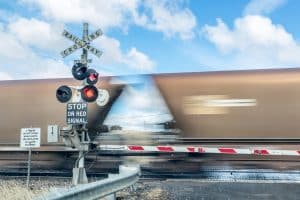Barrington High School Student Hit and Killed at Train Crossing
 Last Friday, friends and family of 17-year-old Marin Lacson held a vigil after the student was struck and killed by a Metra train at Route 59 and Main Street. Friends, students, and family all got together to remember Marin, talking about what made her such a special person.
Last Friday, friends and family of 17-year-old Marin Lacson held a vigil after the student was struck and killed by a Metra train at Route 59 and Main Street. Friends, students, and family all got together to remember Marin, talking about what made her such a special person.
Metra and Barrington police are investigating the train crossing to figure out what happened. Per ABC 7, “A message from Barrington School District 220 said ‘the student was walking to school when the student was accidentally struck by a train on Route 59 and Main Street.’” The Lake County coroner states that Lacson “somehow didn’t see or hear a second train after waiting for one to pass.”
The coroner’s office noted that Lacson attempted to cross the tracks after a train had already passed, and hit by a different train coming from the other direction. Some people speculate that she may have had difficulty seeing the second train due to dense fog.
“It is a somber day in Barrington. Really tough,” said Brian Long of Long’s Jewelry. “Half a block visibility. You can kind of understand how it happened. There’s no reason for it, but you just couldn’t see.”
Our hearts are with Marin’s family, friends, and classmates at this tragic time.
Dangers of rail crossings in Illinois
Only Texas has more rail crossings than Illinois. Our state has over 7300 miles of track with 7,550 public highway-rail crossings and 3,744 private highway-rail crossings. In 2022, there were 148 collisions with 30 fatalities and 45 injuries between trains and motor vehicles or pedestrians at highway-rail crossings. This puts Illinois at number three in the top 15 states for highway-rail crossing collisions, under only California (2) and Texas (1).
Per the Illinois Commerce Commission (ICC), “The six-county Chicago area region accounts for approximately 73 percent (73%) of the State’s risk of experiencing a train-vehicle collision when risk is presented as the product of the number of daily trains and annual average daily highway traffic (AADT).”
The ICC also notes that trespassing is one of the leading causes of railroad-related fatalities. The Federal Railroad Administration defines trespassing as “any person who is on that part of railroad property used in railroad operation and whose presence is prohibited, forbidden, or unlawful.” The only authorized times a person may be on railroad property is at a commuter rail station or a public highway-rail crossing.
Across the country, 2022 saw 2,210 highway-rail crossing collisions with 272 fatalities and 824 injuries.
Rail crossings pose significant dangers to motorists, pedestrians, and cyclists due to a variety of factors that can lead to train accidents and fatalities. These include:
- Some rail crossings have limited visibility due to obstructions such as trees, buildings, or parked vehicles. Poor visibility can make it difficult for motorists and pedestrians to see approaching trains, increasing the risk of collisions.
- Trains are large, heavy vehicles that require significant time and distance to come to a complete stop. Even if a train operator applies the brakes immediately, a train traveling at high speed may not be able to stop in time to avoid a collision with a vehicle or pedestrian at a crossing. In some cases, it can take up to a mile to fully stop a train.
- Motorists and pedestrians may misjudge the speed and distance of approaching trains, leading to attempts to cross the tracks when it is unsafe to do so. Trains often appear to be moving slower than they actually are, especially from a distance, which can create a false sense of security.
- Malfunctions or failures of warning signals, gates, or lights at rail crossings can occur, leading to a lack of warning for motorists and pedestrians. Malfunctioning warning systems increase the risk of accidents by reducing the visibility of approaching trains.
- Distraction, impatience, and inattentiveness among motorists can lead to risky behavior at rail crossings, such as attempting to cross when warning signals are activated or ignoring posted signs and signals.
- Pedestrians and cyclists are particularly vulnerable at rail crossings, especially if they are not using the designated pedestrian pathways or are unaware of oncoming trains. Trespassing on railway tracks or attempting to cross when trains are approaching can have fatal consequences.
- Adverse weather conditions such as fog, rain, or snow can further reduce visibility and make it difficult for motorists and pedestrians to see approaching trains or warning signals at rail crossings.
How can I stay safe at a railroad crossing in Chicago?
The NHTSA discusses a variety of ways to safely cross railroad tracks as a pedestrian or a driver:
- Stop, look both ways, and listen. Remember – trains always have the right of way.
- Never stop on the tracks and ensure you have enough room to get across. Once you enter a railroad crossing, keep moving.
- Stop 15 feet away from flashing red lights, lowered gates, a flagman, or a stop sign.
- Never drive around a lowering or lowered gate, or ignore signals.
- After the train passes, wait for the gate to fully rise and all lights to stop flashing before proceeding.
- Don’t assume there is only one train coming from a single direction.
- If your car stalls on the track, get everyone out of the vehicle quickly, even if you don’t see a train coming. Get away from the tracks and your vehicle to avoid oncoming debris. Call 911.
At Gainsberg Injury and Accident Lawyers, PC, we understand train accidents and the terrible tragedies they can cause. If you or a loved one were harmed in a Chicago train accident, we’re here to help. Talk to us today to find out your rights to compensation for your injuries and losses. To schedule a consultation, simply call our Chicago offices or fill out our contact form.

Attorney Neal Gainsberg has spent the last 20+ years fighting to protect the rights of the injured in Chicago and throughout Illinois. For dedicated legal help with a personal injury, car accident, or wrongful death matter, contact Gainsberg Injury and Accident Lawyers in Chicago for a free consultation.
